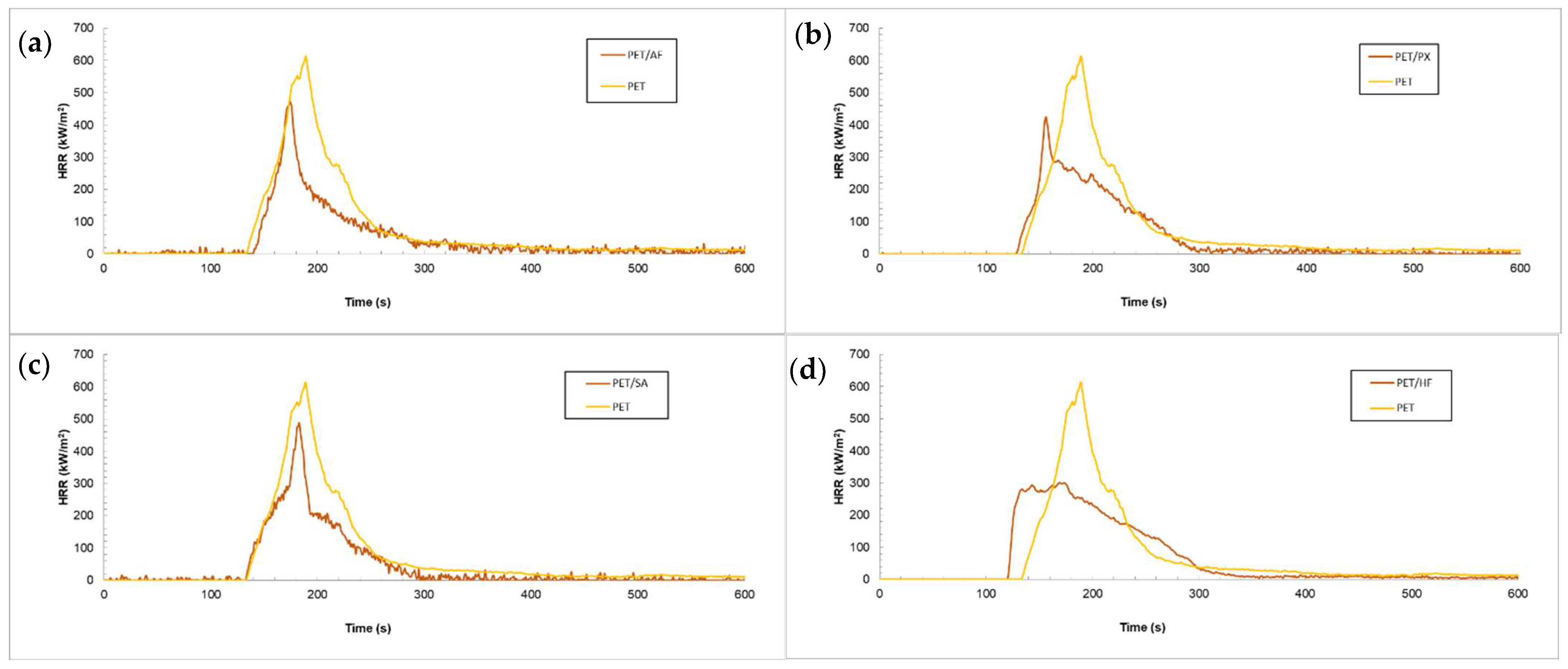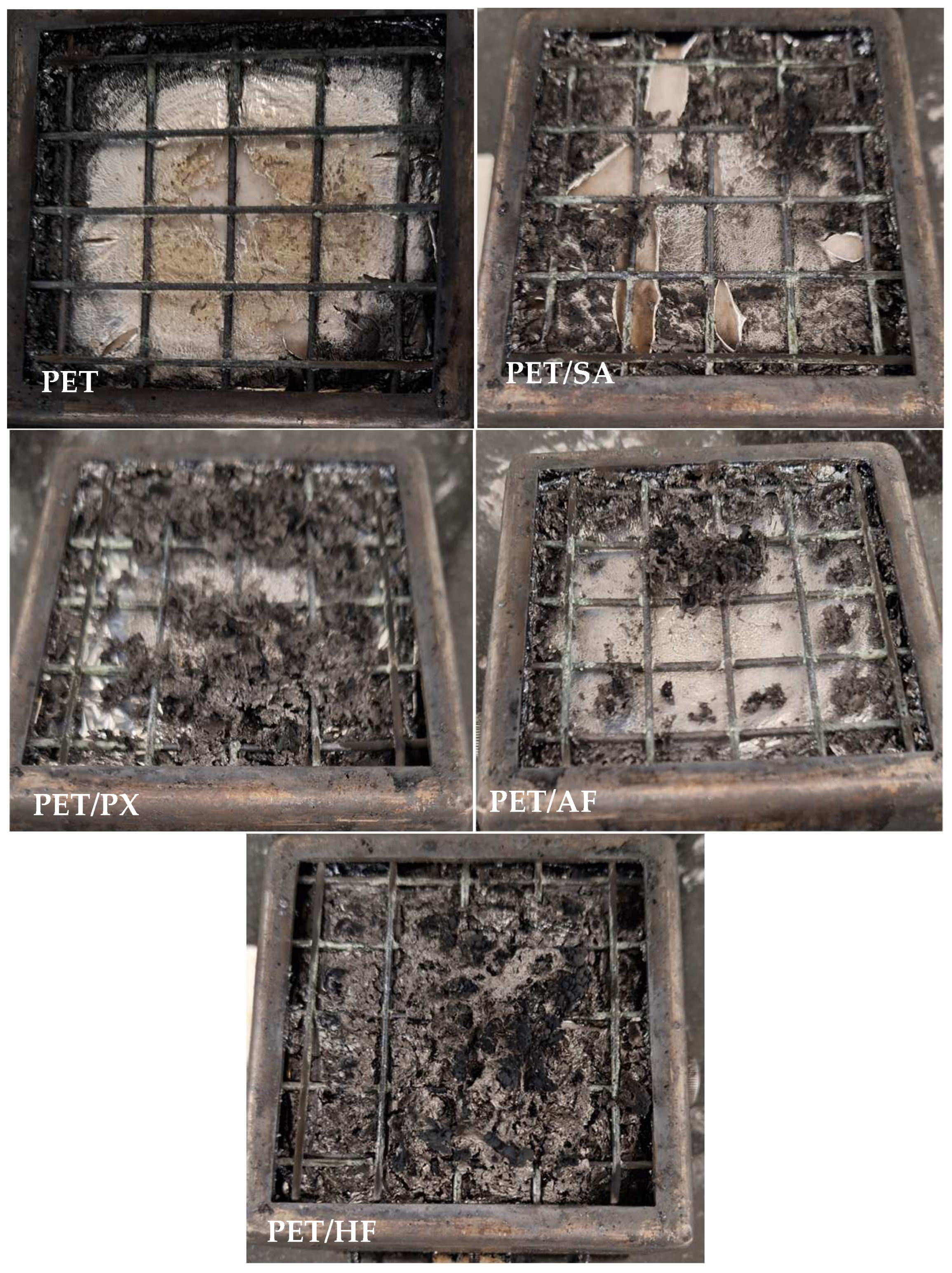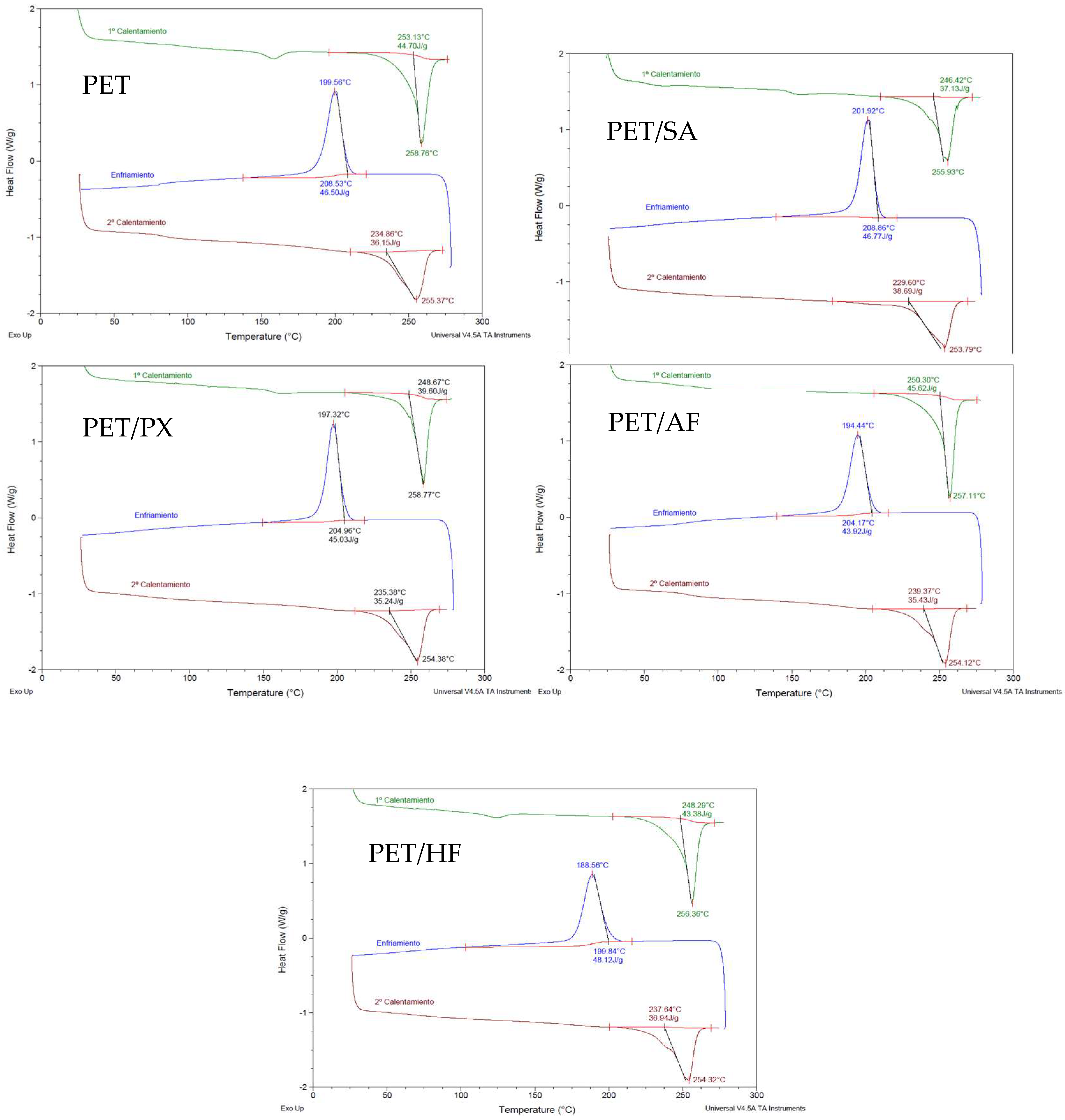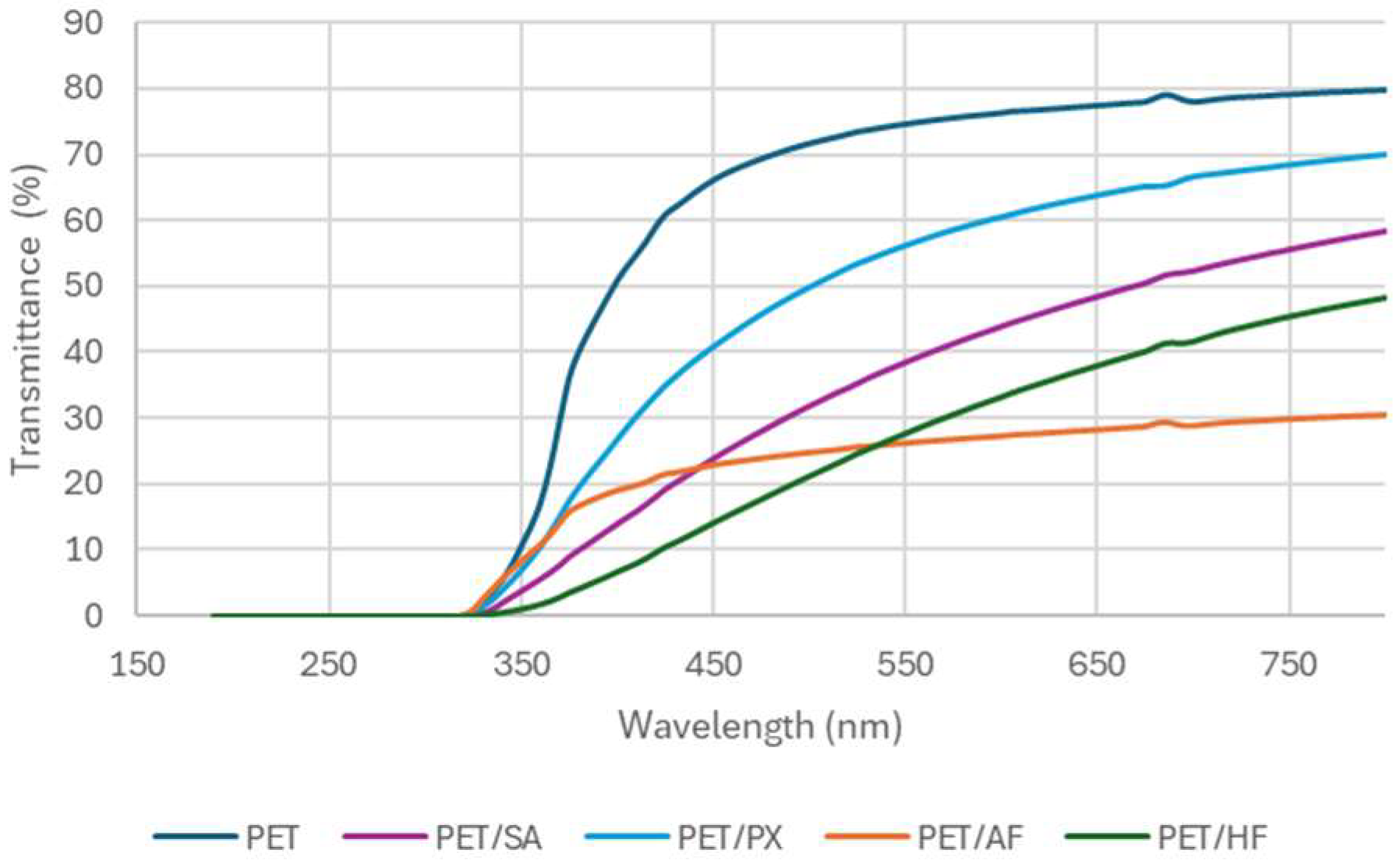A Study on Phosphorous-Based Flame Retardants for Transparent PET Composites: Fire, Mechanical, and Optical Performance
Abstract
1. Introduction
2. Materials and Methods
2.1. Materials
2.2. Preparation of Samples
2.3. Thermal and Fire Behavior Characterization
2.4. Optical and UV Shielding Performance Testing
2.5. Mechanical Characterization
3. Results and Discussion
3.1. Fire Behavior: TGA, Cone Calorimeter, and UL94
3.2. Effect of FR Addition on the Mechanical, Thermal, and Optical Properties of Composites
3.2.1. Mechanical Properties
3.2.2. Optical Properties
- Crystallization of FR PET composites: DSC
- Transparency: light transmission
4. Conclusions
Author Contributions
Funding
Data Availability Statement
Conflicts of Interest
Abbreviations
| PET | Polyethylene terephthalate |
| TGA | Thermogravimetric analysis |
| FGI | Fire growth index |
| FR | Flame retardant |
| DOPO | 9,10-Dihydro-9-oxa-10-phosphaphenanthrene-10-oxide |
| TTI | Time to Ignition |
| HRRpeak | Heat Release Rate Peak |
| THR | Total Heat Release |
| MARHE | Maximum Average Rate Heat Emission |
| TSP | Total Smoke Production |
| SEA | Smoke Extinction Area |
| DSC | Differential Scanning Calorimetry |
| UV–VIS | Ultraviolet–Visible |
References
- Gao, W.; Zhao, Y.; Chen, W.; Zhuang, J.; Shang, M.; Sun, D.; Xie, A. From plastic to supercapacitor electrode materials: Preparation and properties of cobalt oxide/carbon composites with polyethylene terephthalate as carbon source. Ceram. Int. 2023, 49, 7266–7273. [Google Scholar] [CrossRef]
- Molina, A.; Escobar-Barrios, V.; Oliva, J. A review on hybrid and flexible CO2 gas sensors. Synth. Met. 2020, 270, 116602. [Google Scholar] [CrossRef]
- Galstyan, V.; D’Angelo, P.; Tarabella, G.; Vurro, D.; Djenizian, T. High versatility of polyethylene terephthalate (PET) waste for the development of batteries, biosensing and gas sensing devices. Chemosphere 2024, 359, 142314. [Google Scholar] [CrossRef]
- Alonso, C.; Manich, A.; del Campo, A.; Castro, P.F.-D.; Boisseree, N.; Coderch, L.; Martí, M. Graphite flame retardant applied on polyester textiles: Flammable, thermal and in vitro toxicological analysis. J. Ind. Textil. 2022, 51, 4424S–4440S. [Google Scholar] [CrossRef]
- Bastola, A.; He, Y.; Im, J.; Rivers, G.; Wang, F.; Worsley, R.; Austin, J.S.; Nelson-Dummett, O.; Wildman, R.D.; Hague, R.; et al. Formulation of functional materials for inkjet printing: A pathway towards fully 3D printed electronics. Mater. Today Electron. 2023, 6, 100058. [Google Scholar] [CrossRef]
- Jyothi, D.S.; Kumar, J. ITO-PET-based optically transparent circularly polarized fractal wideband antenna for 5G sub-6 GHz band. Sens. Actuators A Phys. 2025, 393, 116804. [Google Scholar] [CrossRef]
- Patil, E.C.; Lokhande, S.D.; Patil, U.A.; Patil, A.U.; Kumar, J. Optically transparent dual-band antenna for UHF and S-band applications. Opt. Mater. 2024, 147, 114615. [Google Scholar] [CrossRef]
- Park, H.K.; Jung, Y.H.; Song, M.J.; Lee, M.C. Quantitative assessment of fire risk in building-integrated photovoltaic (BIPV) modules coated with fire retardant materials for enhanced fire resistance performance. Case Stud. Therm. Eng. 2025, 72, 106285. [Google Scholar] [CrossRef]
- Bhuiyan, E.H.; Behroozfar, A.; Daryadel, S.; Moreno, S.; Morsali, S.; Minary-Jolandan, M. A Hybrid Process for Printing Pure and High Conductivity Nanocrystalline Copper and Nickel on Flexible Polymeric Substrates. Sci. Rep. 2019, 9, 19032. [Google Scholar] [CrossRef]
- Nistico, R. Polyethylene terephthalate (PET) in the packaging industry. Polym. Test. 2020, 90, 106707. [Google Scholar] [CrossRef]
- Horrocks, A.R.; Price, D. Advances in Fire Retardant Materials, 1st ed.; Woodhead Publishing Limited; Elsevier: Amsterdam, The Netherlands, 2008; pp. 9–40. [Google Scholar]
- Shen, J.; Liang, J.; Lin, X.; Lin, H.; Yu, J.; Wang, S. The Flame-Retardant Mechanisms and Preparation of Polymer Composites and Their Potential Application in Construction Engineering. Polymers 2021, 14, 82. [Google Scholar] [CrossRef] [PubMed]
- Price, D.; Horrocks, A.R. Fire Retardancy of Polymeric Materials, 2nd ed.; Wilkie, C.A., Morgan, A.B., Eds.; CRC Press: Boca Raton, FL, USA, 2010; pp. 15–42. [Google Scholar]
- Ren, H.; Liu, X.; Li, Q.; Huang, X.; Wu, H.; Zhang, J. Study of nitrogen-doped carbon quantum dots/sodium lignosulfonate synergistic enhancement of flame retardant properties of polyethylene terephthalate (PET) films. Polym. Degrad. Stab. 2025, 241, 111559. [Google Scholar] [CrossRef]
- Guan, Q.; Deng, X.; Zhang, H.; Zhong, S.; Liu, P.; Zhuang, Y.; Hu, X.; Yao, M.; Neisiany, R.E.; You, Z. Intrinsic flame retarding and non-dripping liquid crystal polyethylene terephthalate copolyesters for fire safety system. Chem. Eng. J. 2023, 453, 139329. [Google Scholar] [CrossRef]
- Gao, F.; Tong, L.; Fang, Z. Effect of a novel phosphorous-nitrogen containing intumescent flame retardant on the fire retardancy and the thermal behaviour of poly(butylene terephthalate). Polym. Degrad. Stab. 2006, 91, 1295–1299. [Google Scholar] [CrossRef]
- Lu, S.-Y.; Hamerton, I. Recent developments in the chemistry of halogen-free flame retardant polymers. Prog. Polym. Sci. 2002, 27, 1661–1712. [Google Scholar] [CrossRef]
- Directive 2009/125/EC of the European Parliament and of the Council of 21 October 2009 Establishing a Framework for the Setting of Ecodesign Requirements for Energy-Related Products (Text with EEA Relevance). 2009. Available online: https://eur-lex.europa.eu/eli/dir/2009/125/oj/eng (accessed on 1 August 2025).
- Yang, Q.; Wang, J.; Chen, X.; Yang, S.; Huo, S.; Chen, Q.; Guo, P.; Wang, X.; Liu, F.; Chen, W.; et al. A phosphorus containing tertiary amine hardener enabled flame retardant, heat resistant and mechanically strong yet tough epoxy resins. Chem. Eng. J. 2023, 468, 143811. [Google Scholar]
- Zhang, A.; Wang, W.; Dong, Z.; Wei, J.; Wei, L.; Gu, W.; Zheng, G.; Wang, R. Mechanical, thermal stability, and flame retarding properties of phosphorus modified PET blended with DOPO-POSS. ACS Omega 2022, 7, 46277–46287. [Google Scholar] [CrossRef]
- Yi, F.; Zhu, C.-J.; Chen, L.; Cao, X.; Ni, S.-P.; Wang, Y.-Z. High-performance flame-retardant PET copolyesters enabled by hydrogen-bonding and phosphorus-nitrogen synergism. Polym. Degrad. Stab. 2025, 240, 111451. [Google Scholar] [CrossRef]
- Ozukanar, O.; Sagdic, G.; Çakmakçı, E.; Özmen, F.K.; Üreyen, M.E.; Gunay, U.S.; Durmaz, H.; Kumbaraci, V. Triazole-, piperazine-, and DOPO-containing eugenol-based reactive flame retardant for unsaturated polyester resin. J. Appl. Polym. Sci. 2024, 141, 56127. [Google Scholar] [CrossRef]
- Alongi, J.; Carosio, F.; Malucelli, G. Current emerging techniques to impart flame retardancy to fabrics: An overview. Polym. Degrad. Stabil. 2014, 106, 138–149. [Google Scholar] [CrossRef]
- Qi, P.; Chen, F.; Li, Y.; Jiang, Y.; Zhu, T.; Sun, J.; Li, H.; Gu, X.; Zhang, S. Environmental benign foam finishing with a hyperbranched polyphosphonate flame retardant for polyethylene terephthalate fabric. Chemosphere 2023, 317, 37892. [Google Scholar] [CrossRef]
- Jo, C.H.; Jang, Y.M.; Mun, D.H.; Yu, C.J.; Choe, C.G.; Ri, S.G. Preparation of acrylic emulsion coating with melamine polyphosphate, pentaerythritol and titanium dioxide for flame retardant cotton/polyethylene terephthalate blend fabrics. Polym. Degrad. Stab. 2023, 214, 110366. [Google Scholar] [CrossRef]
- Zhang, Y.; Zuo, C.; Liu, X.; Ye, Z.; Tan, W.; Li, P.; Ren, Y.; Liu, X. Preparation of flame retardant and anti-dripping PET fabric based on heme chloride dyeing and mussel-inspired strategy. Prog. Org. Coat. 2025, 201, 109097. [Google Scholar] [CrossRef]
- Chen, F.; Qi, P.; Liu, J.; Qian, L.; Sheng, Q.; Chen, J.; Gu, X.; Sun, J.; Zhang, S. Fully bio-based flame retardant and antibacterial coating for polyethylene terephthalate fabric. Prog. Org. Coat. 2023, 182, 107637. [Google Scholar] [CrossRef]
- Dai, K.; Deng, Z.; Liu, G.; Wu, Y.; Xu, W.; Hu, Y. Effects of a reactive phosphorus–sulfur containing flame-retardant monomer on the flame retardancy and thermal and mechanical properties of unsaturated polyester resin. Polymers 2020, 12, 1441. [Google Scholar] [CrossRef]
- Zhang, G.; Song, D.; Ma, S.; Wang, Y.; Xie, X.; Dong, Y. A novel P-S-Si-based cage-structural monomer for flame-retardant modification of unsaturated polyester resin. Polym. Adv. Technol. 2020, 32, 1604–1614. [Google Scholar] [CrossRef]
- Zhang, Q.; Xu, B.; Zhou, H.; Qian, L. A facile strategy to simultaneously enhance the flame retardancy, toughness and ultraviolet shielding performance of unsaturated polyester resin: Adjusting the unsaturated degree of flame retardant. Polymer 2024, 301, 127035. [Google Scholar] [CrossRef]
- Wang, L.-S.; Wang, X.-L.; Yan, G.-L. Synthesis, characterisation and flame retardance behaviour of poly(ethylene terephthalate) copolymer containing triaryl phosphine oxide. Polym. Degrad. Stab. 2000, 67, 127–130. [Google Scholar] [CrossRef]
- Yang, W.; Song, L.; Hu, Y.; Lu, H.; Yuen, R.K. Enhancement of fire retardancy performance of glass-fibre reinforced poly(ethylene terephthalate) composites with the incorporation of aluminum hypophosphite and melamine cyanurate. Compos. Part B Eng. 2011, 42, 1057–1065. [Google Scholar] [CrossRef]
- Ao, X.; Du, Y.; Yu, D.; Wang, W.; Yang, W.; Sun, B.; Zhu, M. Synthesis, characterization of a DOPO-based polymeric flame retardant and its application in polyethylene terephthalate. Prog. Nat. Sci. Mater. Int. 2020, 30, 200–207. [Google Scholar] [CrossRef]
- Oh, J.; Kim, S.S.; Lee, J.; Kang, C. Supercritical fluid flame-retardant processing of polyethylene terephthalate (PET) fiber treated with 9, 10-dihydro-9-oxa-10-phosphaphenanthrene-10-oxide (DOPO): Changes in physical properties and flameretardant performance. J. CO2 Util. 2021, 54, 101761. [Google Scholar] [CrossRef]
- Sablong, R.; Duchateau, R.; Koning, C.E.; Pospiech, D.; Korwitz, A.; Komber, H.; Starke, S.; Häußler, L.; Jehnichen, D.; der Landwehr, M.A. Incorporation of a flame retardancy enhancing phosphorus-containing diol into poly(butylene terephthalate) via solid state polycondensation: A comparative study. Polym. Degrad. Stab. 2011, 96, 334–341. [Google Scholar] [CrossRef]
- Levchik, S.V.; Weil, E.D. A review of recent progress in phosphorus-based flame retardants. J. Fire Sci. 2016, 24, 345–364. [Google Scholar] [CrossRef]
- Ren, J.; Zeng, C.; Zhang, S.; Xu, J.; Tian, H.; Ji, P.; Wang, C.; Wang, H. Enhancing flame retardancy and hydrolysis resistance of flame retardant copolyester fibers by reactive carbodiimide. Polym. Degrad. Stab. 2024, 223, 110713. [Google Scholar] [CrossRef]
- Gu, W.; Wei, L.; Ma, T.; Wu, Y.; Zhang, A.; Wei, J.; Wang, R. Carbon dots as smoke suppression agents for the reduction of CO release in combustion and improvement of UV resistance towards Phosphorus-containing polyester. Eur. Polym. J. 2022, 181, 111642. [Google Scholar] [CrossRef]
- Shi, X.-H.; Li, X.-L.; Li, Y.-M.; Li, Z.; Wang, D.-Y. Flame–retardant strategy and mechanism of fiber reinforced polymeric composite: A review. Compos. Part B Eng. 2022, 233, 109663. [Google Scholar] [CrossRef]
- Liu, H.Y.; Xin, F.; Du, J.Y.; Chen, Y. The behavior and mechanism of tris-(3-dopopropyl)-triazine trione flame retardant polyethylene terephthalate. J. Appl. Polym. Sci. 2023, 140, 1–14. [Google Scholar] [CrossRef]
- Salmeia, K.A.; Gooneie, A.; Simonetti, P.; Nazir, R.; Kaiser, J.P.; Rippl, A.; Hirsch, C.; Lehner, S.; Rupper, P.; Hufenus, R.; et al. Comprehensive study on flame retardant polyesters from phosphorus. Addit. Polym. Degrad. Stab. 2018, 155, 22–34. [Google Scholar] [CrossRef]
- Didane, N.; Giraud, S.; Devaux, E.; Lemort, G. Development of fire resistant PET fibrous structures based on phosphinate-POSS blends. Polym. Degrad. Stab. 2012, 97, 879–885. [Google Scholar] [CrossRef]
- Li, J.; Qin, Z.; Qiao, L.; Yang, R. Mechanical and flame retardant properties of polyethylene terephthalate composites with various structured oligomeric phenyl silsesquioxanes. Polym. Degrad. Stab. 2025, 239, 111390. [Google Scholar] [CrossRef]
- Li, J.; Qin, Z.; Zhai, C.; Yang, R. Study on the synergistic flame-retardancy of phenyl/vinyl siliconesquioxane and aluminum diethyl phosphinate on polyethylene terephthalate. Polym. Degrad. Stab. 2024, 220, 110660. [Google Scholar] [CrossRef]
- Li, X.; Fang, S. Preparation and property analysis of kaolin/melamine cyanurate/aluminum diethylphosphinate/recycled PET composites. J. Appl. Polym. Sci. 2023, 140, 53598. [Google Scholar] [CrossRef]
- Si, M.; Feng, J.; Hao, J.; Xu, L.; Du, J. Synergistic flame retardant effects and mechanisms of nano-Sb2O3 in combination with aluminum phosphinate in poly (ethylene terephthalate). Polym. Degrad. Stab. 2014, 100, 70–78. [Google Scholar] [CrossRef]
- Li, J.; Pan, F.; Xu, H.; Zhang, L.; Zhong, Y.; Mao, Z. The flame-retardancy and anti-dripping properties of novel poly(ethylene terephalate)/cyclotriphosphazene/silicone composites. Polym. Degrad. Stab. 2014, 110, 268–277. [Google Scholar] [CrossRef]
- Zhang, X.; Zhong, Y.; Mao, Z.-P. The flame retardancy and thermal stability properties of poly (ethylene terephthalate)/hexakis (4-nitrophenoxy) cyclotriphosphazene systems. Polym. Degrad. Stab. 2012, 97, 1504–1510. [Google Scholar] [CrossRef]
- Ding, F.; Zhang, S.; Chen, X.; Li, R.; Ren, X. PET fabric treated with environmental-friendly phosphorus-based compounds for enhanced flame retardancy, thermal stability and anti-dripping performance. Compos. Part. B 2022, 235, 109791. [Google Scholar] [CrossRef]
- Ke, Y.; Long, C.; Qi, Z. Crystallization, properties, and crystal and nanoscale morphology of PET–clay nanocomposites. J. Appl. Polym. Sci. 1999, 71, 1139–1146. [Google Scholar] [CrossRef]
- Wu, Y.-H.; Wang, C.-C.; Chen, C.-Y. Nucleation effect of aliphatic polycarbonate in its blends with poly (ethylene terephthalate). Mater. Chem. Phys. 2020, 248, 122920. [Google Scholar] [CrossRef]
- Zhang, Y.; Liu, R.; Yu, R.; Yang, K.; Guo, L.; Yan, H. Phosphorus-free hyperbranched polyborate flame retardant: Ultra-high strength and toughness, reduced fire hazards and unexpected transparency for epoxy resin. Compos. B Eng. 2022, 242, 110101. [Google Scholar] [CrossRef]
- PET: Polyethylene Terephthalate. Available online: https://analyzing-testing.netzsch.com/en-US/polymers-netzsch-com/engineering-thermoplastics/pet-polyethylene-terephthalate (accessed on 1 July 2025).
- ISO 178:2019; Plastics—Determination of Flexural Properties. European Committee for Standardization (CEN): Brussels, Belgium, 2019.
- ISO 179-1:2023; Plastics—Determination of Charpy Impact Properties—Part 1: Non-Instrumented Impact Test. European Committee for Standardization (CEN): Brussels, Belgium, 2023.
- Özer, M.S.; Wesemann, M.-J.; Gaan, S. Flame retardant back-coated PET fabric with DOPO-based environmentally friendly formulations. Prog. Org. Coat. 2023, 175, 107363. [Google Scholar] [CrossRef]
- Sánchez, A.; Villanueva, S. Effect of aryl phosphates on toxicity of combustion gases of flame-retardant polycarbonate/acrylonitrile butadiene styrene blends according to EN 45545 railway standard. Fire Mater. 2022, 46, 1197–1207. [Google Scholar] [CrossRef]
- Pawlowski, K.H.; Schartel, B.; Fichera, M.A.; Jäger, C. Flame retardancy mechanisms of bisphenol A bis(diphenyl phosphate) in combination with zinc borate in bisphenol A polycarbonate/acrylonitrile-butadiene-styrene blends. Thermochim. Acta 2010, 498, 92–99. [Google Scholar] [CrossRef]
- Pawlowski, K.H.; Schartel, B. Flame retardancy mechanisms of triphenyl phosphate, resorcinol bis(diphenyl phosphate) and bisphenol A bis(diphenyl phosphate) in polycarbonate/acrylonitrile–butadiene–styrene blends. Polym. Int. 2007, 56, 1404–1414. [Google Scholar] [CrossRef]
- Levchik, S.V.; Bright, D.A.; Alessio, G.A.; Dashevsky, S. Specialty Polymer Additives, Principles and Applications; Blackwell Science: Oxford, UK, 2001; pp. 259–269. [Google Scholar]
- Bascucci, C.; Duretek, I.; Lehner, S.; Holzer, C.; Gaan, S.; Hufenus, R.; Gooneie, A. Investigating thermomechanical recycling of poly(ethylene terephthalate) containing phosphorus flame retardants. Polym. Degrad. Stabil. 2022, 195, 109783. [Google Scholar] [CrossRef]
- Ayesh, M.; Horrocks, A.R.; Kandola, B.K. The effect of combined atmospheric plasma/UV treatments on improving the durability of organophosphorus flame retardants applied to polyester fabrics. Polym. Degrad. Stab. 2024, 225, 110789. [Google Scholar] [CrossRef]
- Chen, J.; Lehner, S.; Teng, S.Y.; Gaan, S.; Passerone, D.; Heuberger, M.; Gooneie, A. Thermal decomposition mechanisms of phosphorus flame retardants: Acombined theoretical and experimental approach. Polym. Degrad. Stab. 2025, 241, 111543. [Google Scholar] [CrossRef]
- Aguirresarobe, R.; Calafel, I.; Villanueva, S.; Sanchez, A.; Agirre, A.; Sukia, I.; Esnaola, A.; Saralegi, A. Development of Flame-Retardant Polylactic Acid Formulations for Additive Manufacturing. Polymers 2024, 16, 1030. [Google Scholar] [CrossRef] [PubMed]
- Levchik, S.V.; Weil, E.D. Flame retardancy of thermoplastic polyesters—A review of the recent literature. Polym. Int. 2005, 54, 11–35. [Google Scholar] [CrossRef]
- Sato, M.; Endo, S.; Arakl, Y.; Matsuoka, G.; Takeuchi, S.G. The flame-retardant polyester fiber: Improvement of hydrolysis resistance. J. Appl. Polym. Sci. 2000, 78, 1134–1138. [Google Scholar] [CrossRef]
- Wang, Y.Z.; Chen, X.T.; Tang, X.D. Synthesis, characterization, and thermal properties of phosphorus-containing, wholly aromatic thermotropic copolyesters. J. Appl. Polym. Sci. 2002, 86, 1278–1284. [Google Scholar] [CrossRef]
- Rahman, M.; Brazel, C.S. The plasticizer market: An assessment of traditional plasticizers and research trends to meet new challenges. Prog. Polym. Sci. 2004, 29, 1223–1248. [Google Scholar] [CrossRef]
- Fedorko, P.; Djurado, D.; Trznadel, M.; Dufour, B.; Rannou, P.; Travers, J.P. Insulator–metal transition in polyaniline induced by plasticizers. Synth. Met. 2003, 135–136, 327–328. [Google Scholar] [CrossRef]







| References | Composition PET/FR | T Profile (°C) | Screw Revolution (r.p.m.) |
|---|---|---|---|
| PET | PET 100 | 260/285/285/285/285 | 30 |
| PET/SA | PET 93/Sacoflam 7 | 235/245/245/245/245 | 30 |
| PET/PX | PET 92.73/PX 7.27 | 260/285/285/285/285 | 30 |
| PET/AF | PET 97.4/Aflammit 2.6 | 260/270/270/270/270 | 30 |
| PET/HF | PET 89.9/HFR 10.1 | 260/277/277/277/277 | 30 |
| Sample | Ti (°C) | Tmax (°C) | Res450 (%) | Res550 (%) | Res700 (%) |
|---|---|---|---|---|---|
| PET | 353 ± 2 | 423 ± 3 | 17.0 ± 0.1 | 0.0 ± 0.0 | 0.0 ± 0.0 |
| PET/SA | 348 ± 2 | 419 ± 2 | 17.1 ± 0.2 | 2.7 ± 0.1 | 0.2 ± 0.1 |
| PET/PX | 374 ± 4 | 424 ± 4 | 16.8 ± 0.1 | 11.3 ± 0.2 | 0.3 ± 0.1 |
| PET/AF | 357 ± 2 | 421 ± 3 | 16.5 ± 0.1 | 0.3 ± 0.0 | 0.0 ± 0.0 |
| PET/HF | 350 ± 3 | 372 ± 3 | 19.4 ± 0.2 | 7.0 ± 0.2 | 1.5 ± 0.1 |
| Samples | Tignition (s) | HRRpeak (kW/m2) | tHRRpeak (s) | FGI (kW/m2·s) | THR (MJ/m2) | MARHE (kW/m2) | SEA (m2/kg) | CO/CO2 Ratio | TSP (m2) |
|---|---|---|---|---|---|---|---|---|---|
| PET | 139.5 ± 2 | 569.7 ± 15 | 179.0 ± 10 | 3.2 | 41.0 ± 1.9 | 131.4 ± 4.4 | 711 ± 4 | 6.6 × 10−3 | 9.0 ± 1 |
| PET/SA | 151.0 ± 7 | 470.7 ± 18 | 184.0 ± 1 | 2.6 | 25.8 ± 0.7 | 87.7 ± 5.5 | 996 ± 10 | 2.7 × 10−2 | 13.0 ± 0.6 |
| PET/PX | 140.0 ± 0 | 441.0 ± 17 | 154.5 ± 2 | 2.9 | 35.5 ± 6.3 | 95.9 ± 2.7 | 871 ± 6 | 2.4 × 10−2 | 9.3 ± 2 |
| PET/AF | 157.0 ± 3 | 469.1 ± 3 | 176.5 ± 3 | 2.7 | 33.1 ± 5.7 | 91.3 ± 11.3 | 869 ± 15 | 2.3 × 10−2 | 12.2 ± 2 |
| PET/HF | 129.5 ± 1 | 301.4 ± 1 | 159 ± 10 | 1.9 | 44.2 ± 3.8 | 118.8 ± 0.5 | 713 ± 13 | 2.9 × 10−2 | 13.1 ± 0.1 |
| Samples | ∑t1 (s) | ∑t2 (s) | ∑ (t1 + t2) (s) | Rating | Comments |
|---|---|---|---|---|---|
| PET | 37 | 80 | 117 | V2 | Cotton ignited by drops |
| PET/SA | 18 | 8 | 26 | V2 | Cotton ignited by drops |
| PET/PX | 22 | 14 | 36 | V2 | Cotton ignited by drops |
| PET/AF | 0 | 0 | 0 | V0 | No cotton ignition |
| PET/HF | 44 | 35 | 79 | V2 | Cotton ignited by drops |
| Sample | Flexural Modulus (MPa) | Deformation Strength (%) | Flexural Strength (MPa) | Charpy Impact Resistance (kJ/m2) |
|---|---|---|---|---|
| PET | 1693 ± 128 | 3.6 ± 0.2 | 45.4 ± 1.4 | 2 ± 0.7 |
| PET/SA | 1915 ± 82 | 1.2 ± 0.7 | 22.6 ± 13.6 | 1.1 ± 0.2 |
| PET/PX | 1606 ± 29 | 3.6 ± 0.1 | 44 ± 0.7 | 1.6 ± 0.3 |
| PET/AF | 1733 ± 71 | 2.5 ± 0.2 | 40.5 ± 0.8 | 0.8 ± 0.1 |
| PET/HF | 1615 ± 132 | 3.3 ± 0.1 | 39.8 ± 0.5 | 1.7 ± 0.3 |
| Samples | Melting Process | Crystallization Process | Tg (°C) | Xc (%) | ||
|---|---|---|---|---|---|---|
| Tm (°C) | ∆Hm (J·g−1) | Tc (°C) | ∆Hc (J·g−1) | |||
| PET | 255 ± 1 | 38.6 ± 3.5 | 200 ± 2 | 45.0 ± 2.1 | 77–88 | 27.6 ± 2.5 |
| PET/SA | 253 ± 0 | 40.6 ± 2.7 | 202 ± 1 | 44.6 ± 3.1 | -- | 29.0 ± 1.9 |
| PET/PX | 254 ± 0 | 36.9 ± 2.3 | 197 ± 2 | 43.9 ± 1.6 | -- | 26.4 ± 1.7 |
| PET/AF | 253 ± 1 | 38.7 ± 4.6 | 184 ± 2 | 40.0 ± 5.6 | 71–87 | 27.7 ± 3.3 |
| PET/HF | 253 ± 1 | 37.8 ± 1.3 | 189 ± 1 | 41.0 ± 1.1 | -- | 27.0 ± 0.2 |
| Sample | Transmittance at 560 nm (%) |
|---|---|
| PET | 75 |
| PET/SA | 40 |
| PET/PX | 57 |
| PET/AF | 26 |
| PET/HF | 29 |
Disclaimer/Publisher’s Note: The statements, opinions and data contained in all publications are solely those of the individual author(s) and contributor(s) and not of MDPI and/or the editor(s). MDPI and/or the editor(s) disclaim responsibility for any injury to people or property resulting from any ideas, methods, instructions or products referred to in the content. |
© 2025 by the authors. Licensee MDPI, Basel, Switzerland. This article is an open access article distributed under the terms and conditions of the Creative Commons Attribution (CC BY) license (https://creativecommons.org/licenses/by/4.0/).
Share and Cite
Villanueva-Díez, S.; Sánchez-de-Andrés, A. A Study on Phosphorous-Based Flame Retardants for Transparent PET Composites: Fire, Mechanical, and Optical Performance. Polymers 2025, 17, 2191. https://doi.org/10.3390/polym17162191
Villanueva-Díez S, Sánchez-de-Andrés A. A Study on Phosphorous-Based Flame Retardants for Transparent PET Composites: Fire, Mechanical, and Optical Performance. Polymers. 2025; 17(16):2191. https://doi.org/10.3390/polym17162191
Chicago/Turabian StyleVillanueva-Díez, Sara, and Alberto Sánchez-de-Andrés. 2025. "A Study on Phosphorous-Based Flame Retardants for Transparent PET Composites: Fire, Mechanical, and Optical Performance" Polymers 17, no. 16: 2191. https://doi.org/10.3390/polym17162191
APA StyleVillanueva-Díez, S., & Sánchez-de-Andrés, A. (2025). A Study on Phosphorous-Based Flame Retardants for Transparent PET Composites: Fire, Mechanical, and Optical Performance. Polymers, 17(16), 2191. https://doi.org/10.3390/polym17162191







